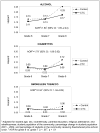Results of a type 2 translational research trial to prevent adolescent drug use and delinquency: a test of Communities That Care
- PMID: 19736331
- PMCID: PMC2740999
- DOI: 10.1001/archpediatrics.2009.141
Results of a type 2 translational research trial to prevent adolescent drug use and delinquency: a test of Communities That Care
Abstract
Objective: To test whether the Communities That Care (CTC) prevention system reduces adolescent alcohol, tobacco, and other drug use and delinquent behavior communitywide.
Design: The Community Youth Development Study is the first randomized trial of CTC.
Setting: In 2003, 24 small towns in 7 states, matched within state, were randomly assigned to control or CTC conditions.
Participants: A panel of 4407 fifth-grade students was surveyed annually through eighth grade. Intervention A coalition of community stakeholders received training and technical assistance to install the CTC prevention system. They used epidemiological data to identify elevated risk factors and depressed protective factors in the community, and chose and implemented tested programs to address their community's specific profile from a menu of effective programs for families, schools, and youths aged 10 to 14 years.
Main outcome measures: Incidence and prevalence of alcohol, tobacco, and other drug use and delinquent behavior by spring of grade 8.
Results: The incidences of alcohol, cigarette and smokeless tobacco initiation, and delinquent behavior were significantly lower in CTC than in control communities for students in grades 5 through 8. In grade 8, the prevalences of alcohol and smokeless tobacco use in the last 30 days, binge drinking in the last 2 weeks, and the number of different delinquent behaviors committed in the last year were significantly lower for students in CTC communities.
Conclusion: Using the CTC system to reduce health-risking behaviors in adolescents can significantly reduce these behaviors communitywide.
Figures



Comment in
-
Understanding the importance of Communities That Care.Arch Pediatr Adolesc Med. 2009 Sep;163(9):866-8. doi: 10.1001/archpediatrics.2009.144. Arch Pediatr Adolesc Med. 2009. PMID: 19736344 No abstract available.
References
-
- Mokdad AH, Marks JS, Stroup DF, Gerberding JL. Actual causes of death in the United States, 2000. JAMA. 2004;291(10):1238–1245. - PubMed
-
- Woolf SH. The big answer: rediscovering prevention at a time of crisis in health care. Harvard Health Policy Rev. 2006;7(2):5–20.
-
- Specter A. Making youth violence prevention a national priority. Am J Prev Med. 2008;34(3, Supplement 1):S3–S4. - PubMed
-
- U.S. Department of Health and Human Services. Youth Violence: A Report of the Surgeon General. Rockville, MD: U.S. Department of Health and Human Services, Substance Abuse and Mental Health Services Administration, Center for Mental Health Services, National Institutes of Health, National Institute of Mental Health; 2001.
-
- Sampson RJ, Laub JH. Life-course desisters? Trajectories of crime among delinquent boys followed to age 70. Criminology. 2003;41(3):555–592.

